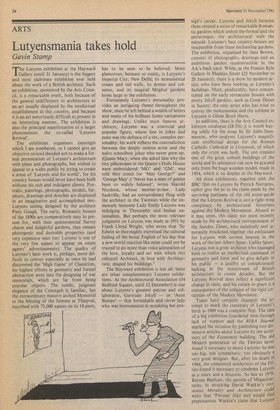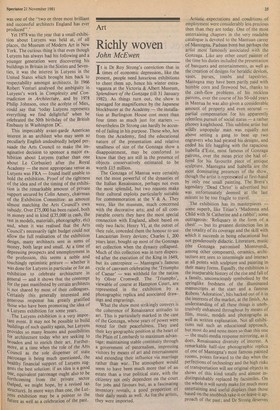ARTS
Lutyensmania takes hold
Gavin Stamp
rr he Lutyens exhibition at the Hayward "Gallery (until 31 January) is the biggest and most elaborate exhibition ever held about the work of a British architect. Such an exhibition, sponsored by the Arts Council, is a remarkable event, both because of the general indifference to architecture as an art usually displayed by the intellectual establishment in this country, and because it is an art notoriously difficult to present in an interesting manner. The exhibition is also the principal manifestation of a larger phenomenon: the so-called `Lutyens Revival'.
The exhibition organisers (amongst which I am numbered, so I cannot give an objective review) decided not to make a formal presentation of Lutyens's architecture with plans and photographs, but wished to appeal to a wider public by trying to create a sense of `Lutyens and his world', for his country houses would never have been built without his rich and indulgent clients. Portraits, paintings, photographs, models, furniture, drawings and sketches are displayed in an imaginative and accomplished neoLutyens setting designed by the architect Piers Gough. The early, Romantic houses of the 1890s are comparatively easy to present for, with their quintessential Surrey charm and delightful gardens, they remain photogenic and desirable properties (and very expensive ones too: Lutyens is one of the very few names to appear on estate agents' advertisements). The quality of Lutyens's later work is, perhaps, more difficult to convey especially as once he had discovered the 'High Game' of Classicism, his highest efforts in geometry and formal abstraction went into the designing of war memorials, which are far from being popular objects. The subtle, poignant elegance of the Cenotaph is familiar, but the extraordinary massive arched Memorial to the Missing of the Somme at Thiepval, inscribed with 73,000 names on its 16 piers, has to be seen to be believed. More glamorous, because so exotic, is Lutyens's Imperial City, New Delhi; its monumental cream and red walls, its domes and columns, and its magical Moghul gardens loom large in the exhibition.
Fortunately Lutyens's personality provides an intriguing theme throughout the show, since he left behind a wealth of letters and many of his brilliant funny caricatures and drawings. Unlike most famous architects, Lutyens was a convivial and popular figure, whose line in jokes and puns was the defence of a shy, complex personality; his work reflects the contradiction between the deeply serious artist and the naive schoolboy joker who never grew up. (Queen Mary, when she asked him why the tiny pillowcases in the Queen's Dolls House were embroidered `MG' and 'GM', was told they stood for 'May George?' and 'George May'.) 'Never has a man of genius been so widely beloved', wrote Harold Nicolson, whose mother-in-law, Lady Sackville, had an extraordinary fling with the architect in the Twenties while the immensely tiresome Lady Emily Lutyens was indulging in Theosophy and Indian nationalism. But perhaps the most relevant judgment on Lutyens was made in 1951 by Frank Lloyd Wright, who wrote that 'Sir Edwin so thoroughly expressed the cultural feeling of the better English of his day that a new-world reaction like mine could not be trusted to do more than voice admiration of the love, loyalty and art with which this cultured Architect, in love with Architecture, shaped his buildings.'
The Hayward exhibition is not all: there are other complementary Lutyens exhibitions. At the Architectural Association (34 Bedford Square, until 12 December) is one about Lutyens's greatest patron and collaborator, Gertrude Jekyll — or 'Aunt Bumps' — that formidable and clever lady who was instrumental in moulding her pro tege's career. Lutyens and Jekyll between them created a series of remarkable Romantic gardens which united the formal and the picturesque, the architectural with the natural. Lutyens's best country houses are inseparable from these enchanting gardens. The exhibition, organised by Jane Brown, consists of photographs, drawings and an ambitious garden reconstruction in the AA's back yard. While, at the Francis Kyle Gallery in Maddox Street (23 November to 20 January), there is a show by modern artists who have been looking at Lutyens's buildings. Most, predictably, have concentrated on the early vernacular houses with pretty Jekyll gardens, such as Great Dixter in Sussex; the only artist who has tried to convey the monumental and the sublime in Lutyens is Glenn Boyd Harte.
In addition, there is the Arts Council exhibition catalogue (£8.50); it is worth buying solely for the essay by Sir John Summerson, who analyses Lutyens's magnificent intellectual design for the Roman Catholic Cathedral in Liverpool, of which only the crypt was built. The rest remains one of the great unbuilt buildings of the world and its splendour can now be grasped only from the huge wooden model, made in 1934, which is on display in the Hayward.
All these exhibitions, together with the BBC film on Lutyens by Patrick Nuttgens, rather give the lie to the claim made by the surviving partisans of the old avant-garde that the Lutyens Revival is just a right-wing conspiracy by architectural historians against the Modern Movement. Absurd as it may seem, this claim was most recently made by the architectural correspondent of the Sunday Times, who tastelessly and ignorantly bracketed together the enthusiam for Lutyens with current interest in the work of the late Albert Speer. Unlike Speer, Lutyens was a great architect who managed both to realise an intellectual command of geometry and form and to give delight to his public — a quality so conspicuously lacking in the mainstream of British architecture in recent decades. But the Lutyens Revival does reflect a significant change in taste, and his return to grace is a consequence of the collapse of the rigid certainties of the Modern Movement.
Times have certainly changed: the attempt to mark the centenary of Lutyens's birth in 1969 was a complete flop. The idea of a big exhibition foundered then through lack of support and the RIBA Journal marked the occasion by publishing two dis missive articles about Lutyens by the architects of the Economist building. The old Modern generation of the Thirties riever found it necessary to abuse Lutyens: he was too big, too sympathetic, too obviouslya iii 1944, great designer. But, after his death n 1944, the committed modernists of the Fifties found it necessary to condemn Lutyens as a snare and a delusion. As late as 1978, Reyner Banham, the apostle of Megastruc.tures, in attacking David Watkin's revisionist Morality and Architecture could write that 'Pevsner (like me) would find preposterous Watkin's claim that Lutyens was one of the "two or three most brilliant and successful architects England has ever produced".'
Yet 1978 was the year that a small exhibition about Lutyens was held at, of all places, the Museum of Modern Art in New York. The curious thing is that even though Lutyens has always had his following and a younger generation were discovering his buildings in Britain in the Sixties and Seventies, it was the interest in Lutyens in the United States which brought him back to respectability amongst architects. In 1966 Robert Venturi analysed the ambiguity in Lutyens's work in Complexity and Contradiction in Architecture, and by 1978 Philip Johnson, once the acolyte of Mies, could say that 'today Lutyens represents everything we find delightful' when he celebrated the 50th birthday of the British Embassy in Washington DC.
This impeccably avant-garde American interest in an architect who may seem so peculiarly English undoubtedly helped persuade the Arts Council to make the imaginative decision to sponsor a major exhibition about Lutyens (rather than one about Le Corbusier) after the Royal Academy — the most appropriate venue as Lutyens was FRA — found itself unable to hold the exhibition. Proof of the rightness of the idea and of the timing of the exhibition is the remarkable amount of private support secured by Colin Amery, chairman of the Exhibition Committee: an amount almost matching the Arts Council's own subsidy. Over E75,000 has been raised, both in money and in kind (05,000 in cash, the rest in models, materials, photography, etc) and, when it was realised that the Arts Council's necessarily tight budget could not allow the full realisation of the exhibition design, many architects sent in sums of money, both large and small. At a time of depressing prospects and unemployment in the profession, this seems a noble and touchingly optimistic gesture — whether it was done for Lutyens in particular or for an exhibition to celebrate architecture in general — and it shows that the contempt for the past manifested by certain architects Is not shared by most of their colleagues. Certainly this generally interested and generous response has greatly gratified those who have been promoting the idea of a Lutyens exhibition for some years.
The Lutyens exhibition is a very important event. It may not be possible to build buildings of such quality again, but Lutyens Provides so many lessons and possibilities for architecture today who are seeking to broaden and to enrich their art. Furthermore, at a time when the role of the Arts Council as the sole dispenser of state Patronage is being much questioned, the healthy financial support of Lutyens suggests the best solution: if an idea is a good °tie, equivalent patronage ought also to be forthcoming from the private sector (helped, we might hope, by a revised tax structure). In more ways than one, the LutYens exhibition may be a pointer to the future as well as a celebration of the past.











































 Previous page
Previous page